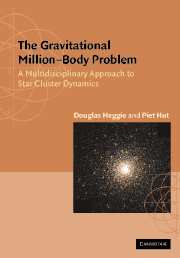Book contents
- Frontmatter
- Contents
- Preface
- PART I INTRODUCTIONS
- 1 Astrophysics Introduction
- 2 Theoretical Physics Introduction
- 3 Computational Physics Introduction
- 4 Mathematical Introduction
- PART II THE CONTINUUM LIMIT: N → ∞
- PART III MEAN FIELD DYNAMICS: N = 106
- PART IV MICROPHYSICS: N = 2
- PART V GRAVOTHERMODYNAMICS: N = 106
- PART VI GRAVITATIONAL SCATTERING: N = 3
- PART VII PRIMORDIAL BINARIES: N = 4
- PART VIII POST-COLLAPSE EVOLUTION: N = 106
- PART IX STAR CLUSTER ECOLOGY
- Appendix A A Simple N-Body Integrator
- Appendix B Hints to Solution of Problems
- References
- Index
3 - Computational Physics Introduction
Published online by Cambridge University Press: 05 June 2012
- Frontmatter
- Contents
- Preface
- PART I INTRODUCTIONS
- 1 Astrophysics Introduction
- 2 Theoretical Physics Introduction
- 3 Computational Physics Introduction
- 4 Mathematical Introduction
- PART II THE CONTINUUM LIMIT: N → ∞
- PART III MEAN FIELD DYNAMICS: N = 106
- PART IV MICROPHYSICS: N = 2
- PART V GRAVOTHERMODYNAMICS: N = 106
- PART VI GRAVITATIONAL SCATTERING: N = 3
- PART VII PRIMORDIAL BINARIES: N = 4
- PART VIII POST-COLLAPSE EVOLUTION: N = 106
- PART IX STAR CLUSTER ECOLOGY
- Appendix A A Simple N-Body Integrator
- Appendix B Hints to Solution of Problems
- References
- Index
Summary
Following the evolution of a star cluster is among the most computer-intensive and delicate problems in science, let alone stellar dynamics. The main challenges are to deal with the extreme discrepancy of length and time scales, the need to resolve the very small deviations from thermal equilibrium that drive the evolution of the system, and the sheer number of computations involved. Though numerical algorithms of many kinds are used, this is not an exercise in numerical analysis: the choice of algorithm and accuracy are dictated by the need to simulate the physics faithfully rather than to solve the equations of motion as exactly as possible.
Length/time scale problem
Simultaneous close encounters between three or more stars have to be modelled accurately, since they determine the exchange of energy and angular momentum between internal and external degrees of freedom (Chapter 23). Especially the energy flow is important, since the generation of energy by double stars provides the heat input needed to drive the evolution of the whole system, at least in its later stages (Chapter 27). Unfortunately, the size of the stars is a factor 109 smaller than the size of a typical star cluster. If neutron stars are taken into account, the problem is worse, and we have a factor of 1014 instead, for the discrepancy in length scales.
The time scales involved are even worse, a close passage between two stars taking place on a time scale of hours for normal stars, milliseconds for neutron stars (Table 3.1).
Information
- Type
- Chapter
- Information
- The Gravitational Million–Body ProblemA Multidisciplinary Approach to Star Cluster Dynamics, pp. 23 - 31Publisher: Cambridge University PressPrint publication year: 2003
